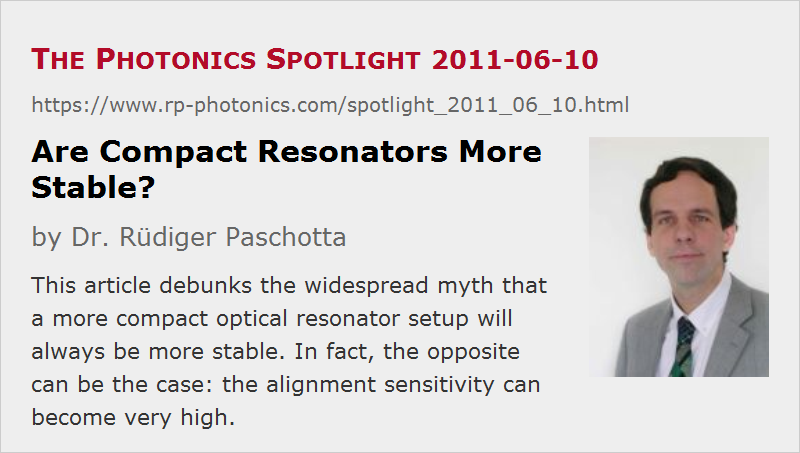Are Compact Resonators More Stable?
Posted on 2011-06-10 as a part of the Photonics Spotlight (available as e-mail newsletter!)
Permanent link: https://www.rp-photonics.com/spotlight_2011_06_10.html
Author: Dr. Rüdiger Paschotta, RP Photonics Consulting GmbH
Abstract: This article debunks the widespread myth that a more compact optical resonator setup will always be more stable. In fact, the opposite can be the case: the alignment sensitivity can become very high.
Ref.: encyclopedia articles on optical resonators, alignment sensitivity of optical resonators, resonator design

One of the widespread myths in photonics is that the more compact an optical resonator (e.g., a laser resonator) is, the more robust and stable it will be. As with nearly every myth, there is some truth in it. Surely, it is easier to make a compact mechanical setup stable and thus to prevent vibrations, for example, from having strong effects on the alignment. However, the sensitivity of the resonator to small misalignments (called alignment sensitivity) is in fact often increased when the resonator length is reduced. As a result, the overall robustness may be decreased, despite the tentatively more robust mechanical properties.
A Simple Example
A simple example demonstrates that point convincingly, without using complicated calculations or software. Imagine that we need a simple linear resonator, consisting of a plane mirror and a concave (focusing) mirror. The latter must have a suitable radius of curvature such that the fundamental mode has a certain beam radius in the resonator. (For a laser resonator, the right mode size is often very important for obtaining good beam quality, a high slope efficiency, etc.) The shorter the resonator, the weaker will be the required curvature of the focusing mirror.
Now imagine a small angular misalignment of the curved mirror, while the plane mirror remains fixed. This misalignment simply makes the resonator mode shift transversely to a new position, where it is again perpendicular to the surface of the curved mirror. (Obviously, the mode always has to be perpendicular to both mirror surfaces.) It becomes clear now that a weak curvature – as needed for a short resonator – implies a larger transverse shift of the mode for a given misalignment angle. And this is bad. Consider, for example, such a shift in the resonator of an end-pumped laser: it will decrease the overlap between the laser beam and the pumped region.
The Problem is Common
One may believe that the discussed example is only an unusual pathological case, but it isn't: any type of resonator will exhibit this problem if you try to make it shorter and shorter while maintaining the mode size. Fundamentally, you are then pushing the resonator into a regime where the effect of diffraction becomes weak (simply because there is little propagation distance), mirror curvatures have to become correspondingly weaker, and the alignment becomes very sensitive. It is not good to have a resonator length far below the Rayleigh length of the intracavity beam.
A common case is that of a Q-switched laser, which we like to be compact partly because this gives us the shortest pulse duration. The mode size, however, cannot be reduced arbitrarily, because we often need to extract energy from the whole pumped volume in the laser crystal without employing higher-order modes (which would spoil the beam quality), and possibly because a too small mode leads to optical damage of resonator components. We then run exactly into that problem: the resonator will be compact and mechanically stable, but its alignment sensitivity may nevertheless be high.
Well, you might think, this simply means that we need a very good mechanical setup, and initially align that very carefully. However, misalignment is not only caused by mechanical tilts, but also by thermal effects such as thermal lensing in the laser crystal. Even exceptional mechanical stability can therefore not fully solve this problem.
A Deep Understanding Helps
Even though the problem is fundamental and cannot be eliminated with a simple design trick, it is essential to precisely understand such issues when designing laser resonators. First of all, one needs to be aware of the problem, and know that compactness is not necessarily the key to stability. Furthermore, one can at least select the best possible laser resonator design. What “best possible” means, depends on the concrete requirements. Therefore, finding the best solution is only possible after carefully analyzing these requirements, including the relative importance of various design goals. Having done this, one can decide for a type of design and finally employ advanced laser resonator design software to optimize the design.
This article is a posting of the Photonics Spotlight, authored by Dr. Rüdiger Paschotta. You may link to this page and cite it, because its location is permanent. See also the RP Photonics Encyclopedia.
Note that you can also receive the articles in the form of a newsletter or with an RSS feed.
Questions and Comments from Users
Here you can submit questions and comments. As far as they get accepted by the author, they will appear above this paragraph together with the author’s answer. The author will decide on acceptance based on certain criteria. Essentially, the issue must be of sufficiently broad interest.
Please do not enter personal data here; we would otherwise delete it soon. (See also our privacy declaration.) If you wish to receive personal feedback or consultancy from the author, please contact him e.g. via e-mail.
By submitting the information, you give your consent to the potential publication of your inputs on our website according to our rules. (If you later retract your consent, we will delete those inputs.) As your inputs are first reviewed by the author, they may be published with some delay.
 |





If you like this page, please share the link with your friends and colleagues, e.g. via social media:
These sharing buttons are implemented in a privacy-friendly way!